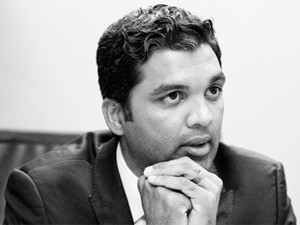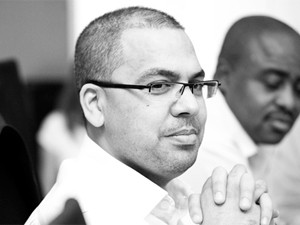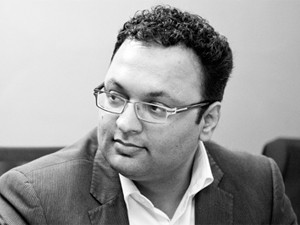
Any potentially explosive discussion is likely to begin slowly. Invited analyst of the day, Clinton Jacobs from BMI-TechKnowledge (BMI-T), eases into things by immediately pulling big data, cloud and mobile off the table, at least initially: "(Excluding those and) from a functional point of view, what innovation is taking place in ERP at the moment?"
Meryl Malcomess, marketing director at SYSPRO, believes the big innovative thing in ERP is the ability to integrate simple supply chains with complex supply chains. To illustrate her point, she tells of a woman in rural Kenya with a few cows and more milk than she can use. If the simple supply chain of which she is part is integrated with the more complex industrial supply chain featuring dairies, wholesalers and retailers, she can easily get her excess milk to market.
Thabo Ndlela, director of IFS, offers another perspective by pointing out that the fundamental architecture of ERP systems has lately become more modular. "That might not count as an innovation, but it's actually made a huge business difference. Some of the earlier ERP systems always came as a stack, (but now), you don't really have to buy the whole stack," he says.
Tarun Gujral, sales director at In2IT Technologies SA, describes what we have at present as ERP 3, which is beginning to see social media as an integral part of a company's business processes. The next phase, he says, will involve integrating ERP with the Internet of things, which, if nothing else, will dramatically simplify the process of keeping an asset register.
Geoffrey Francis, application sales consulting director for Oracle SA, reminds the panel that ERP in its earlier iterations was about putting every single business process into a single, centrally-controlled basket.
Mix-and-match
However, Francis says over the past five to 10 years, the architecture of ERP systems has evolved to become more service-orientated, which now allows customers to decouple individual business processes. This, he contends, enables them to move away from the everything-in-one-basket, or from one supplier, paradigm.
Malcomess says the key to success in such a mix-and-match world is integration. The fact that we can integrate our complex systems or our central database to the more dispersed supply chain means, fundamentally, that we can simplify it, she points out.
Kirtan Sita, GM of EOH SAP Services, echoes that sentiment: "In the hyper-connected world, instant provisioning is the latest innovation we've seen in ERP. Reducing complexity for the infrastructure or the proliferation of infrastructure are concepts we see. That, and a need for business to transform and respond effectively if it wants to be any part of this process," he says.
Sita suggests the conventional top-down approach to ERP has gone the way of the Dodo, because business is no longer willing to accept multi-year implementation cycles. "Business is demanding quick response, agility and shorter cycles. In fact, there's a mining house in SA, where 12 000 employees were implemented on an HR system within 12 weeks, end-to-end. That's the type of disruptive innovation we're seeing right now," he says.
Morn'e Swanepoel, COO at AccTech Systems, concurs with the call for integration, which he says is critical between a business' ERP system, productivity suite and social media.
Some of the earlier ERP systems always came as a stack, (but now), you don't really have to buy the whole stack.
Thabo Ndlela, director, IFS
MyERP Software MD Stephen Corrigan values collaboration between competing vendors more highly, because, he suggests, that's how integration between disparate systems comes about. He credits advances of the past five to 10 years to technology such as Web services.
By this point, it has become apparent that despite Jacobs' request not to do so, virtually every speaker has mentioned cloud or mobile or both.
Mix-and-match
Jacques du Buisson, MD of Silversoft, continues the trend by pointing out that the emphasis of ERP vendors on cloud and mobile has almost revitalised the technology by giving it more of a front-office focus. "It's giving the end-user the device they require... (to do their jobs) in a simple, integrated way that gets rid of complexity, regardless of the accounting package in the background," he says.

On that point, Ndlela notes that user interfaces in ERP software have changed significantly in recent years. "Today, you can tailor-make them for a specific user, so if it's a simple clerk in a store or a warehouse, he'll probably only see what he really needs to see," he says.
Turning the conversation back to integration, Stuart Scanlon, sales and marketing director for New Era Solutions, suggests the shift from a wholly proprietary approach by ERP vendors to the current embrace of open systems and standards has helped to facilitate the easier integration available today.
His counterpart from Dac Systems, Louis Laurie, agrees and notes there have been a lot of innovations on the implementation side that have both shortened implementation time and simplified integration between disparate systems. "We can put up an ERP system in less than an hour these days. In the old days, that was a huge issue. Some of us are old enough to remember that," he recalls.
New opportunities
Collin Govender, VP of systems integration for T-Systems, indicates that ERP vendors in the past did not pay enough attention to user interfaces. "Most users are accustomed to intuitive designs and very nice interfaces. When they end up in an organisation, they've got these clunky, un-integrated interfaces with which they have to work," he says.
"For those of us who worked with some of the larger ERP vendors, their interfaces are horrendous, to say the least, but at the same time, bringing the different worlds together, talking about integration, creates an opportunity to do something really special with the user interface. We didn't have the opportunity to do that before," adds Govender.
Having given up on trying to stop the panellists from talking about cloud and mobile, BMI-T's Jacobs decides to tackle the issues head-on: "We're all aware of the four mega-trends of technology: cloud, mobile, social and big data. So, having covered cloud and social media, how are mobile and big data affecting ERP?"

Sita believes some of the opportunity around the cloud and mobile is actually to adapt enterprise platforms to meet the demands of the users of those systems.
Scanlon takes an old-school approach when he adds that people tend to overcomplicate these issues by giving customers too many options. He contends that putting in 100 data fields when customers only use 10 of them is a waste of developer time and effort.
Similarly, he implies that some vendors have been known to issue updates because they are a revenue source, rather than to fix real problems.
Sita prefers to see the glass as half-full: "One of the areas in which we've seen the opportunities is in the demand-driven adoption of the platform. Users and businesses are taking control of those areas (and) becoming true information knowledge workers," he asserts.
Malcomess comes down on the side of caution, pointing out that control is one thing, but too much complication is something else again.
Meanwhile, Ndlela lauds the effect mobility has had on his company's products, particularly in the oil and gas industry where lost or mislaid paperwork can cost or delay payment of seven-figure invoices. "Mobility has pretty much transformed that industry," he adds.
Affirmation
Govender supports Ndlela's view, citing a large European airplane manufacturer as an example (There's more than one? - Ed). An engineer is able to look at a plane engine and, using a tablet computer, establish the service history of every individual component, while also being able to track the histories of those same components in other engines.
We can put up an ERP system in less than an hour these days. In the old days, that was a huge issue.
Louis Laurie, marketing and sales director, Dac Systems
This, he contends, has dramatically improved the quality of aircraft maintenance, with obvious implications for safety, and is an example of innovation coming from ERP vendors.
Sita echoes the sentiment, pointing out there's a difference between mobile, the device, and mobility, the workforce. "The opportunity in innovation to get mobile in ERP is extending it to new communities in different formats," he says.
Govender gives another example: "One of the exciting things we've seen is with Johannesburg Roads Agency (JRA). We developed a pothole reporting app," he says.
The plan was simply to put a service into citizens' hands, and afterwards, in the background, it was connected into the JRA scheduling system. "JRA now fixes potholes four times faster than it did before," he reports.
Corrigan implies the true power of mobility in the enterprise lies in the ability to easily and cost-effectively develop apps that extend ERP to every employee within the organisation as well as to customers and suppliers.
If you cannot lower a customer's risk and provide value quickly, you will never be adopted in the mid-market.
Geoffrey Francis, application sales consulting director, Oracle SA
Du Buisson believes that mobility and cloud is changing the business models of ERP vendors because clients are demanding easy-to-buy, easy-to-implement, easy-to-run solutions that are priced in an annuity model.
Jacobs suggests the market for ERP among large corporates is "pretty saturated" and asks how the big ERP vendors are making themselves more attractive to the SME sector.
Changing models
Laurie says new licensing deals and flexibility based on per-user, per-month metrics are the way to capture the SME market. "In recent deals, we're also financing the development and configuration of the ERP (on that basis)," he adds.
Swanepoel adds that customer organisations must be mature enough for ERP before an implementation can succeed. To an extent, he says, it's about choosing the right product for the right client in terms of their requirements and maturity.

Francis offers what he calls a tier-one ERP vendor perspective: "The challenge mid-market and small customers have is risk. So apart from licensing costs, it's the implementation. If you cannot lower a customer's risk and provide value quickly, you will never be adopted in the mid-market," he says.
Du Buisson says his market is primarily professionals: consultants, auditors, engineers, etc. "Their definition of the cloud is: you give me the software, you give me the hardware, you do my upgrades and support, you provide online training and you charge us $25 a month.
"So you have to make it easy to buy, you have to remove the complexity and you have to make it easy to get an ERP system up quickly," says Du Buisson.
Govender addresses the issue of competitive advantage: "It's an interesting 'fight' that customers have because they say, if I buy the same ERP as everybody else, where is my opportunity for differentiation and innovation?"
Gujral takes issue with Jacobs' suggestion that the ERP market in corporates is "saturated".
"There's still a lot of space in large companies," he says. On the subject of SMEs, he believes smaller companies are embracing the cloud faster than their larger counterparts.
Evolution, not revolution
Sita says ERP technology - even from tier-one vendors - has evolved and is no longer the sole province of large corporates. "Also, innovation happens in the smalls places, within the small business arena, and your large enterprises get to take advantage of those innovations," he says.
Ndlela believes customers are looking for agility, for an ERP that is modular and flexible enough to be deployed quickly. "They want to address specific business problems; it's less about the technology gimmicks but solving particular business problems," he says.

This is why, he suggests, Gartner and MintJutras predict a growth of cloud-based ERP solutions to 45% over the next 10 years (2023).
Scanlon suggests adoption of online ERP is slow and the primary cause is generational. "In the SME sector, the old X-generation is busy setting up businesses and struggles to adapt to systems that come preconfigured, whereas the younger generation is happy to pick it up and run with the ball," he says.
Corrigan reiterates an earlier comment about customer maturity and asserts that customers are demanding more and more from their ERP software.
Jacobs wraps up the discussion with a useful summary of the issues that stand out for him: simplification, speed and agility of implementation and integration. He also singles out cloud as a "disruptive force within ERP" that is changing the way the industry needs to think about delivering cloud.
He is also intrigued by the apparent need in the mid-market to make ERP easy to buy, with an ability to grow quickly to address very specific needs.
Share